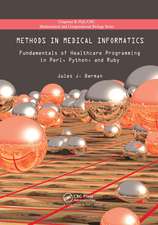Melanins: Functions, Biotechnological Production, and Applications
Editat de Guillermo Gosseten Limba Engleză Hardback – 29 apr 2023
The melanins form a group of polymeric pigments found in most organisms. These natural products are generated by the oxidation of phenolic and indolic molecules yielding melanins, which include eumelanin, pheomelanin, pyomelanin, and the allomelanins. These pigments have diverse biological functions, including photoprotection, thermoregulation, antioxidation, virulence, and metal ion sequestration. Melanins have physicochemical properties that have proven useful in the optical, electronic, material, agriculture, cosmetic, pharmaceutical, and medical industries.
The chapters in this book provide an in-depth analysis of the current issues and challenges in this field. Topics covered include the properties, biogenesis, and evolution of melanosomes.
The book also addresses the synthesis and industrial production of melanins by microorganisms. The metabolic pathways for the synthesis of several types of polymeric pigments in microorganisms and their role in pathogenesis are reviewed. The large-scale production and purification of melanins to provide this product for industrial applications is a formidable challenge. Two chapters present and discuss the state-of-the-art used for the generation of microbial melanin-production strains and the processes for the biotechnological synthesis and purification of these pigments.Melanins are polymers that can interact with metals, a chapter reviews this capacity in the context of technological applications, including electrochemical energy storage and metal recovery. These polymers are materials having favorable characteristics for photonic applications, including UV blocking and broadband absorption. The current advances in the application of these pigments in optically active materials are presented and discussed.
| Toate formatele și edițiile | Preț | Express |
|---|---|---|
| Paperback (1) | 873.63 lei 38-44 zile | |
| Springer International Publishing – 30 apr 2024 | 873.63 lei 38-44 zile | |
| Hardback (1) | 1106.79 lei 3-5 săpt. | |
| Springer International Publishing – 29 apr 2023 | 1106.79 lei 3-5 săpt. |
Preț: 1106.79 lei
Preț vechi: 1349.74 lei
-18% Nou
Puncte Express: 1660
Preț estimativ în valută:
211.81€ • 229.99$ • 177.92£
211.81€ • 229.99$ • 177.92£
Carte disponibilă
Livrare economică 01-15 aprilie
Preluare comenzi: 021 569.72.76
Specificații
ISBN-13: 9783031277986
ISBN-10: 3031277988
Pagini: 146
Ilustrații: VII, 146 p. 25 illus., 21 illus. in color.
Dimensiuni: 155 x 235 mm
Greutate: 0.39 kg
Ediția:2023
Editura: Springer International Publishing
Colecția Springer
Locul publicării:Cham, Switzerland
ISBN-10: 3031277988
Pagini: 146
Ilustrații: VII, 146 p. 25 illus., 21 illus. in color.
Dimensiuni: 155 x 235 mm
Greutate: 0.39 kg
Ediția:2023
Editura: Springer International Publishing
Colecția Springer
Locul publicării:Cham, Switzerland
Cuprins
Chapter 1 Melanin synthesis in bacteria: who, how and why.- Chapter 2 The role of melanin in fungal disease.- Chapter 3 Melanosome origins, diversity and functional relevance across animals.- Chapter 4 Biotechnological production of melanins with recombinant microorganisms.- Chapter 5 Extraction, purification, and characterization of microbial melanin pigments.- Chapter 6 Exploiting melanin-metal interactions for emerging technologies.- Chapter 7 Fundamentals and applications of optically active melanin-based materials.
Notă biografică
Guillermo Gosset was awarded a Ph.D. degree in Biotechnology from the Universidad Nacional Autónoma de México (UNAM) in 1993. Since 1988 he has been a research scientist at the Biotechnology Institute/UNAM. His main research interests are related to metabolic pathway engineering and microbial physiology. Gosset’s work has appeared in more than 121 publications and been included in 8 patents. Several of these publications are utilized as examples in textbooks in the field of metabolic engineering. His industrial experience includes two years as a visiting scientist at Genencor International (Palo Alto, U.S.A.) and one year at Metabolic Explorer (Clermont-Ferrand, France). He is member of the editorial board of the Microbial Physiology (formerly known as Journal of Molecular Microbiology and Biotechnology), where he has been a Senior Editor since 2006. He has also been the Associate Editor of Microbial Cell Factories since 2014.
Textul de pe ultima copertă
This book provides an up-to-date overview of the biological functions of melanins, their biotechnological production, and their industrial applications.
The melanins form a group of polymeric pigments found in most organisms. These natural products are generated by the oxidation of phenolic and indolic molecules yielding melanins, which include eumelanin, pheomelanin, pyomelanin, and the allomelanins. These pigments have diverse biological functions, including photoprotection, thermoregulation, antioxidation, virulence, and metal ion sequestration. Melanins have physicochemical properties that have proven useful in the optical, electronic, material, agriculture, cosmetic, pharmaceutical, and medical industries.
The chapters in this book provide an in-depth analysis of the current issues and challenges in this field. Topics covered include the properties, biogenesis, and evolution of melanosomes.
The book also addresses the synthesis and industrial production of melanins by microorganisms. The metabolic pathways for the synthesis of several types of polymeric pigments in microorganisms and their role in pathogenesis are reviewed. The large-scale production and purification of melanins to provide this product for industrial applications is a formidable challenge. Two chapters present and discuss the state-of-the-art used for the generation of microbial melanin-production strains and the processes for the biotechnological synthesis and purification of these pigments.
Melanins are polymers that can interact with metals, a chapter reviews this capacity in the context of technological applications, including electrochemical energy storage and metal recovery. These polymers are materials having favorable characteristics for photonic applications, including UV blocking and broadband absorption. The current advances in the application of these pigments in optically active materials are presented and discussed.
The melanins form a group of polymeric pigments found in most organisms. These natural products are generated by the oxidation of phenolic and indolic molecules yielding melanins, which include eumelanin, pheomelanin, pyomelanin, and the allomelanins. These pigments have diverse biological functions, including photoprotection, thermoregulation, antioxidation, virulence, and metal ion sequestration. Melanins have physicochemical properties that have proven useful in the optical, electronic, material, agriculture, cosmetic, pharmaceutical, and medical industries.
The chapters in this book provide an in-depth analysis of the current issues and challenges in this field. Topics covered include the properties, biogenesis, and evolution of melanosomes.
The book also addresses the synthesis and industrial production of melanins by microorganisms. The metabolic pathways for the synthesis of several types of polymeric pigments in microorganisms and their role in pathogenesis are reviewed. The large-scale production and purification of melanins to provide this product for industrial applications is a formidable challenge. Two chapters present and discuss the state-of-the-art used for the generation of microbial melanin-production strains and the processes for the biotechnological synthesis and purification of these pigments.
Melanins are polymers that can interact with metals, a chapter reviews this capacity in the context of technological applications, including electrochemical energy storage and metal recovery. These polymers are materials having favorable characteristics for photonic applications, including UV blocking and broadband absorption. The current advances in the application of these pigments in optically active materials are presented and discussed.
Caracteristici
Comprehensive overview on the biological functions of melanins Discusses biotechnological methods for the extraction, synthesis, and purification of melanins Reviews current and future applications of melanins in the optical and medical fields




















